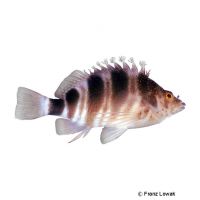Redspotted Hawkfish (Amblycirrhitus pinos)
| Redspotted Hawkfish Amblycirrhitus pinos | |
|---|---|
| Name | Redspotted Hawkfish |
| Name Lat. | Amblycirrhitus pinos |
| Family | Hawkfishes |
| Family lat. | Cirrhitidae |
| Order | Basses |
| Order lat. | Centrarchiformes |
| Origin | Western Atlantic |
| Habitat | Coral reefs |
| Diet | Carnivore |
| pH | 8.1-8.4 |
| Hardness | 8-10 °KH |
| Behavior | Semi-aggressive |
| Keeping | Individual, pair |
| Reef Compatible | Yes |
| Care Level | Moderate |
| Life Span | N/A |
| Protection | No |
| Metric Units | |
| Size | 9 cm |
| Temperature | 22-26 °C |
| Salinity | 33-36 ‰ |
| Aquarium | ~ 250 l |
| US Units | |
| Size | 3" |
| Temperature | 72-79 °F |
| Salinity | 1.020-1.025 sg |
| Aquarium | ~ 65 gal |
Distribution and habitat
The distribution area of Amblycirrhitus pinos is the western Atlantic, from Florida through the Gulf of Mexico and the Caribbean to Brazil. They mostly live on shallow coastal reefs between rocks and corals.
Maintenance
They need a well-structured aquarium with a reef structure (coral sticks), which offers hiding, resting and covering possibilities, with living stones, which act like a biological filter and with their porous structure offer the cleaning bacteria and microorganisms settlement area and habitat. Only lime-rich, heavy metal-free sands, gravels, stones or sea sand may be used. Filters, skimmers and heaters are necessary to ensure water quality, as well as pumps to simulate tides, swells and bottom currents. Lighting must be appropriate for the species' day-night rhythm
| Salinity: 33-36 ‰ | pH value: 8.1-8.4 |
| Carbonate hardness: 8-10 °KH | Nitrate content: 2-8 mg/l |
| phosphate content: 0.01-0.1 mg/l | nitrite content: 0.0-0.05 mg/l |
For salinity, an average value should be aimed for, which may only vary slightly by +/- 0.5 ‰. Ammonia and ammonium must not be measurable. Special attention must be paid to constantly good water quality.
Diet
They are voracious lurkers that prefer to eat shrimp, crustaceans and small fish. The feed change is unproblematic. The food supply should consist of a combination of Artemia, Mysis, shrimps and krill. In addition, chopped fish, mussel and shrimp meat and a frozen food mix and live food shrimp. It is recommended to feed larger portions 1-2 times a day
Regular and varied feeding promotes health and increases resistance.
Behaviour and compatibility
They choose roosting sites from which they can overlook as large an area as possible. It is recommended to keep them in pairs. They are moderately territorial and usually defend only a small area. Interspecific aggression usually occurs only through food competition. A socialization with other, not too small fish, is well possible.
Sex dimorphism
They are probably simultaneous hermaphrodites (simultaneous hermaphrodites) whose role distribution is determined by the respective dominance status. No external distinguishing characteristics are known.
Reproduction and breeding
Spawning takes place in the evening or at night. The fish catapult themselves synchronously to the water surface and then immediately return to the starting point. A successful breeding in the aquarium has not succeeded so far.
Important
They are very jumpy, especially during spawning, so the aquarium should be well covered. As coral reef dwellers, they should only be kept together with corals and not in a fish-only aquarium.
If different species are kept together, care should be taken to ensure that the fish match each other in terms of water quality and temperature requirements and social behavior, and that the setup meets the needs of all species kept together. New fish to be introduced must be acclimated slowly to the water in the aquarium.
Further literature can be found in your pet store.
References
Text: Werner Winter; Image: Franz Lowak
Source: ENGELMANN (2005): Zootierhaltung - Tiere in menschlicher Obhut: Fische, Verlag Harri Deutsch
- Gemäß § 21 Abs. 5 Tierschutzgesetz idgF
